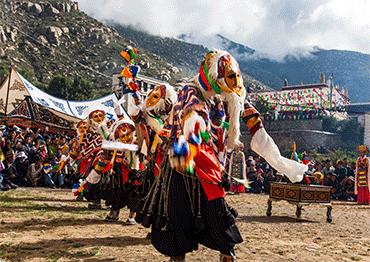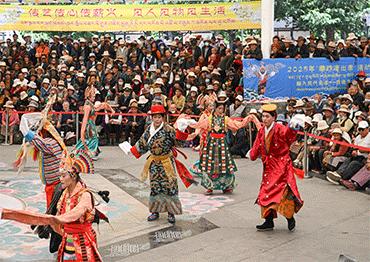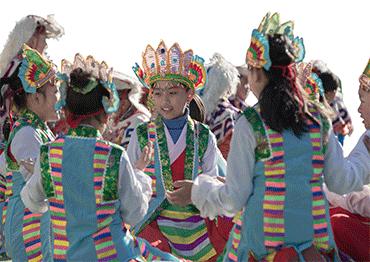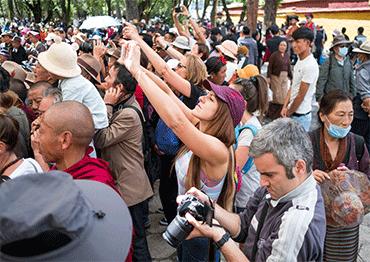Tibetan Opera was listed as China’s national intangible cultural heritage in 2006 and included on UNESCO’s list of Oral and Intangible Heritage of Humanity in 2009.��
The blue-mask school, known in Tibetan as Ache Lhamo (“fairy sisters”), is a form of secular theater dating back more than 600 years. Its origins can be traced back more than 1,000 years to folk beliefs and ritual activities, possibly as early as the region’s pre-Buddhist era around the 8th century. It incorporates elements of history, folklore, legend and Buddhist teachings.
“Tibetan Opera plays a significant role in the lives of rural communities,” said Sangye Dondrup, a researcher and art commentator from the National Art Institute of Xizang in Lhasa.
Around 1430, the monk and engineer Thangtong Gyalpo built iron suspension bridges across major rivers on the plateau, including the Yarlung Zangbo River (the highest altitude river in the world), to improve transportation.
To raise funds, he recruited seven young women from among his builders to perform traditional Tibetan songs and dances. “That’s how the school got the name Ache Lhamo, or ‘fairy sisters,’” Sangye Dondrup told NewsChina.
During the rule of the Fifth Dalai Lama (1618-1682), Tibetan Opera became increasingly secular and eventually emerged as an independent dramatic form. “By the 18th century, Buddhist stories translated into Tibetan began to merge with local folk tales, giving rise to full repertoires,” he said.
A typical Tibetan Opera performance consists of three parts: a prologue featuring clowns or spirits to bless the performance, the main narrative and an epilogue offering prayers and blessings. The prologue features a ceremonial dance and chant by seven blue-masked hunters, two berobed gyalu (prefects) and seven dakinis (celestial fairies). These rituals, according to Sangye Dondrup, purify the performance space and invite celestial beings. Before the main story begins, performers salute their patron saint, the engineer-monk Thangtong Gyalpo.
The eight traditional repertoires are based on biographies of heroes and heroines drawn from magic tales, ancient legends, historical records and Buddhist teachings. These stories focus on loyalty, karma, enlightenment and moral values, often telling of young heroes who overcome hardships to become kings or attain spiritual achievements.
Performers are judged on their rhythmic movements and the quality of their arias, which vary by gender, emotion, plot and character. Comedic interludes and improvisations add to the atmosphere. “It’s an art form rich in artistic elements,” Tenzin Yeshe said. “There are over 20 types of arias and more than 200 distinct body movements. I’m trying to decode the meaning behind each of them, their expressive functions and aesthetic principles.”
Traditionally, Tibetan Opera is performed in open circular spaces that accommodate hundreds or even thousands of spectators. They attract entire communities, who stay for seven or eight hours, enjoying meals and picnics as part of the event. Although nearly everyone in the audience knows the stories and songs, it remains a joyful experience, particularly for older viewers.
“Tibetan Opera has always been for the people, especially farmers, as a way to spread Buddhist teachings in an accessible form,” Sangye Dondrup said. “Now, its inheritance is taking two directions. One is traditional open-air performances by part-time troupes across Tibetan areas. The other is professional stage productions in modern theaters organized by institutions such as the Tibetan Opera Troupe run by the local government.”
To meet the demands of modern audiences, Tibetan Opera is most often performed in theaters with improved acoustics. Shows typically last about two hours and are put on in both city centers and rural communities.
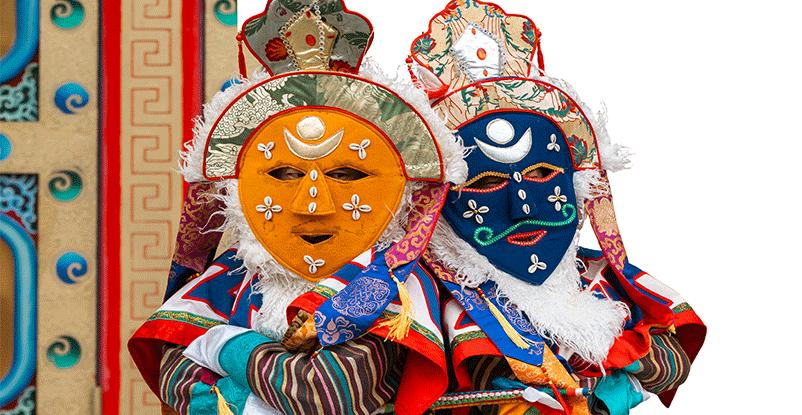
 Old Version
Old Version

